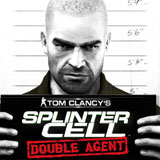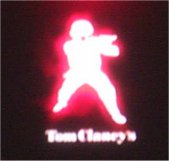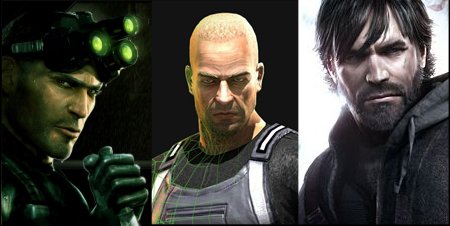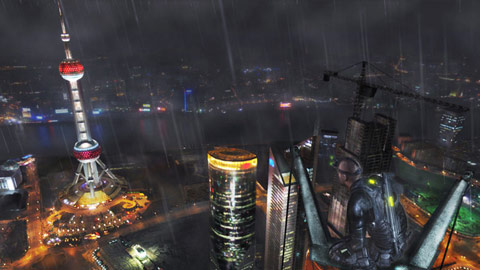
Tom Clancy’s Splinter Cell Double Agent
Platform: Xbox 360
Genre: Stealth-Action
I’ll get this out of the way up front, Tom Clancy has sold out so much that “Tom Clancy’s” is now a brand with it’s own logo. Look here it is taken off my TV using a rubbish digital camera. It exists, at least in my mind, purely to be made fun of.

Tom Clancy’s what, anyway? Tom Clancy’s a big sell-out. Haha, I funny.
That aside, Tom Clancy’s Splinter Cell Double Agent, is the 4th Splinter Cell for those of you who are counting. This game had a slightly unusual development cycle which resulted in two almost entirely different games being created by two different development teams, but which shared the same name and many common elements. Ubisoft Montreal (who developed the original Splinter Cell, and SC: Chaos Theory) developed a version of the game for the PS2, Gamecube and Xbox, and Ubiosoft Shanghai (who produced Splinter Cell Pandora Tomorrow) developed another version for the PC, 360 and PS3. The best way to describe effect of this would to imagine what would happen if two different developers had been given the same initial design document, then made their own game without communicating. The premise, rough plot/level outline, characters and voice actors are the same, but the level design, story, dialogue, and game mechanics are totally different.
I have played the PS2 version and the 360 version which I am reviewing here. I tried to play PC version but it’s so shockingly broken that it couldn’t actually be played as far as I could tell. For those interested; 1) The game wouldn’t even install without looking up a work-around on a forum. 2) The graphics were so glitchy it looked like I was stuck in the big brother logo. 3) They had removed a lot of the keyboard customisation options, so I couldn’t set it up like the previous Splinter Cell games I’d played on the PC.
So as you are hopefully aware, in Splinter Cell you are Sam Fisher and you spend most of your time sneaking around places and being shouted at by someone named Lambert every time you don’t sneak quite sneakily enough. In this outing, Sam has for various reasons volunteered to be a Double Agent to infiltrate a terrorist organisation called John Brown’s Army or JBA. The members of JBA are such evil bastards I’m surprised they get anything done as they are all too busy being evil bastards to each other. Sam Fisher effortlessly gains their trust by breaking one of their members out of prison. Sam is so confident in his abilities as a double agent that he doesn’t even feel the need to change his name. Presumably, Third Echelon is so secret that they’ve actually managed to erase all mention of him from everywhere, so they couldn’t just Google ‘Sam Fisher’ or something.
Sam has always been a fairly amiable fellow and a rare example of a protagonist older than the age of 20, but he’s never managed to quite shake the stigma of being a sort of poor man’s Solid Snake. His character is slightly diminished by the fact that his design changes so massively between the games that you’d be forgiven for thinking he’s a totally different person. In many ways he only really becomes Sam Fisher when he puts on his signature goggles, which he often forgets to bring with him in this game. In one mission you do get sunglasses which you can take off and on to alter the amount of eye-melting bloom you are subjected to.

The classic Fisher is on the left. Fisher from Double Agent in the middle, where he looks so much like Lincoln Burrows from Prison Break that it’s suspicious, especially considering one of the levels feels like it was lifted right out of an aborted Prison Break game. On the right is his new design for Splinter Cell Conviction, where he looks like a sort of hobo version of Brian Ekberg from Gamespot.com.
The main part of any Splinter Cell game is the sneaking, and while playing it I couldn’t help but feel that at some point during the game’s development, the designers had started throwing the word ‘steamline’ around with reckless abandon. What they tried to do here was streamline, what they actually did was dumb it down. Rather than the normal analogue slider style visibility meter, what we get this time is a big traffic signal on your back which shows Green if you are in shadow, Yellow if you aren’t, and Red if someone’s shooting bullets at you. Noticeably absent is the Sound meter, in fact I’m not sure noise is even factored into this stealth model this time. Because of this boolean state of visible/invisible, you never know how close you are to becoming visible, which is so very important in a game of this type.
The normal way for me to player Splinter Cell games is to sneak up behind people, grab them, take them somewhere dark and knock them out. This time round, you really aren’t given enough information about how effectively you are sneaking up on someone, and half the time you end up alerting them somehow which means a reload. Fortunately the game has quick-save which is quite actually reasonably quick I suppose. These two things lead to a rather high reload count while playing. You can fuck up so easily and without warning that you’ll probably find your self saving after you do almost anything successfully, even if it’s just walking down an empty corridor.
When you are sneaking and get close enough, a ‘grab dude’ icon appears and you are meant to jab A at that point, but it only seems to work some of the time, and if it doesn’t work you get promptly shot. The bonus for grabbing dudes is that you get to interrogate them which is often vaguely amusing and sometimes actually helpful. Eventually I realised it was more hassle than it’s worth, and just used the ‘knock out’ trigger to getting rid of them. Amusingly Sam’s way of knocking people out is to punch them incredibly hard in the back of the head. This leads to some absolutely hilarious sequences where you smash people’s faces into toilets, vending machines and computer monitors. My enjoyment of the game skyrocketed with the discovery of this move.

Look, it’s the place the game was developed!
The graphics and environments in this game are absolutely wonderful. The stand out sequence (which was oddly missing from the version that wasn’t developed in Shanghai) is an area which beautifully models the view from the roof of a skyscraper hotel in Shanghai of all places. The developers have a real knack for making realistic looking environments; they were the geniuses responsible for the train sequence in Pandora Tomorrow as well. Another level models a cruise-ship with such loving attention to detail that it looks almost real, dammit! Not so good is the bloody JBA headquarters which looks incredibly dreary in comparison and it’s a damn shame because you spend over half the game in it, but I’ll get on to that later.
Actually, I’ll get on to it now. Perhaps the most ‘new’ and ‘innovate’ thing in the game that isn’t actually new or innovative even though everyone said it is, are the undercover sequences. The undercover concept was originally done in Thief: The Dark Project, in a mission actually called ‘Undercover’. During three agonising levels, your JBA buddies leave you unsupervised for precisely 25 minutes, during which you have to sneak into the countless secure areas of base, which is an entire block of New York they seem to have taken over without anyone noticing (even though they intend to blow the city up). You walk around pretending to be a normal JBA member, but when no-one is looking you go of riffling through filing cabinets and getting spotted doing so through walls by apparently psychic guards. These missions are an immense chore, and virtually impossible to beat fully without using a FAQ as the timing is so tight it’s like planning a bank robbery. I think that the most annoying thing is that all three times its essentially the same mission, and it all just seems like a rather half baked ploy to make the game seem longer than it really is.
Occasionally, if you are anything like me, you’ll probably feel like using your guns to shoot actual bullets, rather than weird washer things that apparently knock people out, and you’ll be pleased to hear that the guns are quite effective this time. You can kill people with a single burst of fire but you’ll be punished harshly in the mission stats, and they don’t give you enough ammo for extended murder sprees. The game employs a halo-style recharge based health system, rather than the breaking-into-a-bathroom-cabinet-and-steal-some-paracetamol system of the previous games. I guess it works okay, but you mostly won’t take damage that doesn’t kill you instantly, except when Sam doesn’t feel like grabbing a ladder you are attempting to descend and just sort of plummets off the edge. Enemies themselves are deadly with thier guns, and you aren’t exactly wearing Gears of War variety body armour, so you’ll drop quicker than you’d probably expect.
All in all I find it hard to recommend this game to anyone, except for seasoned Splinter Cell players who have no doubt finished this game months ago. If you don’t already like stealth-based games then this game is certainly not going to convince you that they’re great, as stealth has been handled much better many times before. To the Splinter Cell veteran, what you are getting is a shiny but stripped down experience, but not stripped down to a point that makes it terrible per say, it’s just sort of confusing. Why are features like the sound meter, wall-split-jump, and the swat turn missing? Why does half the game take place in one dreary building? What the hell was up with that Matrix-guff training sequence? And so on.
You may have noticed I didn’t talk about multiplayer at all, that’s because I don’t care. It may well be excellent, but I still don’t care. So there.
Arbitrary Rating: 7 – Yeah, Pretty Good.
Recent Comments